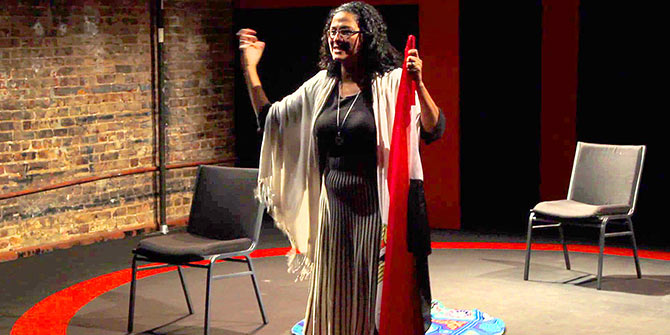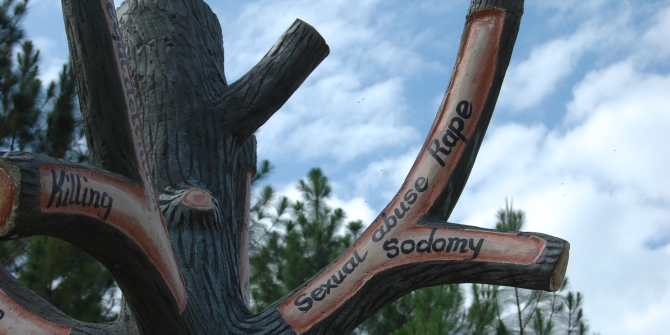LSE’s Simone Datzberger discusses the challenges to eradicate FGM as a broadly accepted practice in many African societies.
On 28 November 2012, world news bulletins were headlined with the usual tragedies: the Palestinian case, Syria, the Egyptian crisis and the latest events in Iraq. A few newspapers even featured the M23 uprising in DR Congo – next to Lindsay Lohan’s self-destructive nightclub adventures. What barely received any coverage, however, is the remarkable approval of the first UN General Assembly draft resolution, which calls for an end to Female Genital Mutilation (FGM) – a torturous procedure, which affects the lives of no less than roughly 150 million girls and women worldwide.

In short, FGM as described by Waris Dirie’s campaign and organisation ‘Desert Flower’ is: “(…) A destructive operation, during which the female genitals are partly or entirely removed or injured with the goals of inhibiting a woman’s sexual feelings. Most often the mutilation is performed before puberty, often on girls between the age of four and eight, but recently it is increasingly performed on nurslings who are only a couple of days, weeks or months old. (…) The procedure is usually performed without anesthetic and under catastrophic hygienic circumstances. Knives, scissors, razor blades or pieces of broken glass are used as instruments among others.”
Clitoridectomy is believed to date as far back as the 5th century BC in Egypt. It is not widely known that it was also a conventional practice in the 19th and early 20th century in Europe as a cure for “mental diseases”. A personage no less than Sigmund Freud contended: “The elimination of clitoral sexuality is a necessary precondition for the development of femininity.” The procedure was finally banned in Europe and North America between the early eighties and nineties. Today, FGM is primarily an African phenomenon. In 2012, it still affects around 90% of all females in Djibouti, Egypt, Ethiopia, Eritrea, Sierra Leone, Somalia and Sudan; and more or less, 50% of girls and women in Benin, Burkina Faso, Central African Republic (CAR), Chad, Cote d’Ivoire, Gambia, Guinea, Guinea Bissau, Kenya, Liberia, Mali, Nigeria and Togo. In some instances, it also occurs in South-east Asia or among immigrant communities in Europe.
In an attempt to stem these shockingly high numbers, a vast number of anti-FGM awareness campaigns and training led by the international community and mainly Western civil society organisations emerged. According to the UN, “Over the past three years, some 8,000 communities across the world, including 15 African countries, have abandoned the practice. Last year alone, 2,000 communities declared that they will no longer allow the human rights violation to continue.” The new draft resolution – although not legally binding – is an additional and crucial step forward. Still, the torture is far from being fully eradicated as a cultural habit. The FGM Education and Networking Project finds that it remains a broadly and publicly accepted procedure in the African societies listed above and the number of girls mutilated does not appear to be reducing dramatically. There are various reasons why it is so complex to bring female circumcision to an end. Not only is FGM a tradition deeply embedded in the culture of several African countries, it also requires an enormous amount of time and continuous effort to burst through the various societal networks that practise and support it.
Here are some of the biggest challenges in the fight against FGM:
FGM as an initiation to womanhood
FGM is not simply an act of circumcision. In most cases, girls undergo a week-long training in the bush as an initiation to the role and responsibilities of socially-respected young women and future wives. Non-circumcised girls are often thought of being unclean and face tremendous challenges in finding a husband. In some societies, a failure to be initiated could be a one-way street to social margnialisation, if not even stigamtisation.
FGM as a broadly accepted institution
Interviews with about 50 local civil society organisations in Sierra Leone revealed that the majority perceived FGM as an important institution that needs to be maintained, albeit under better hygienic conditions. Around a third stated that the process of initiation should be preserved but without the cutting. In some instances, interviewees felt that FGM prevents young girls from teenage pregnancy and prostitution. Public opinion on FGM differs, of course, from country to country and depends largely on the percentage of girls habitually circumcised.
FGM as an “incentive” and the influence of secret societies
What makes the process of initiation very attractive for girls is that it is often accompanied with an endowment in the form of new clothes; jewelry and other accessories of which many young women are fond. It is no exception that families remain highly indebted until years after their daughter’s initiation. In addition, large payments have to be made to professional circumcisers, usually women who enjoy a high reputation or belong to highly respected secret societies. Probably, the most commonly known secret society is the Sande also known as Bundu or Bondo in the West African region. Their social status and influence does certainly play a crucial role as to why FGM remains an accepted practice and custom by the broader public.
Impunity despite torturing
Countries with no specific laws against FGM include: Cameroon, DR Congo, Liberia, Mali, Mauritania, Nigeria, Sierra Leone and Somalia. Although legally banned in Benin, Burkina Faso, CAR, Chad, Cote d’Ivoire, Djibouti, Egypt, Eritrea, Ethiopia, Ghana, Guinea, Guinea Bissau, Kenya, Niger, Senegal, Sudan and Uganda – there were (with a few exceptions only) hardly any convictions in any of these countries. Notably, FGM continues to be widely practiced in developed African countries such as Egypt where it is estimated that about 97% of all women are circumcised.[i]
Combating the practice of FGM requires male support
In an official statement on 28 November 2012, UN Secretary General Ban Ki-Moon stated: “We need men to change their mentality.” In patriarchal societies, male dominance has the potential to do both either impede or strengthen efforts in changing mindsets towards FGM. Acknowledging the importance to bring more men on board, the UN campaign UNITE to End Violence against Women has recently introduced a Network of Men Leaders to address violence against women. At the local level, men also have the power to influence women’s networks performing and financially benefiting from FGM. Hence, stopping circumcision as a practice will only be successful up to a certain point if it remains an issue largely tackled and discussed by women only – at regional and international levels. Male support is essential to eradicate centuries-long mindsets of perceiving FGM as a cultural tradition, which is no less than gruesome torture.
[i] For more statistics access:
http://www.desertflowerfoundation.org/uploads/Prevalence-of-FGM-and-Legal-Situation.pdf,






It is the only topic I have encountered real problems with. In 2005 I was working with a large group of graduates at The British Council, Freetown. Many of them were ‘educated’ women and when I raised the subject I was told that I did not understand all the cultural aspects associated with genital alteration. I noted my feelings, they accepted that and we moved on.
In rural areas it remains part of life and I don’t know how to interfere without promoting hostility. Gender issues always cause problems and this one, despite support from leading politicians, is deep rooted and followed generation after generation.
Thank you John for your additional and (as usual) insightful comments!